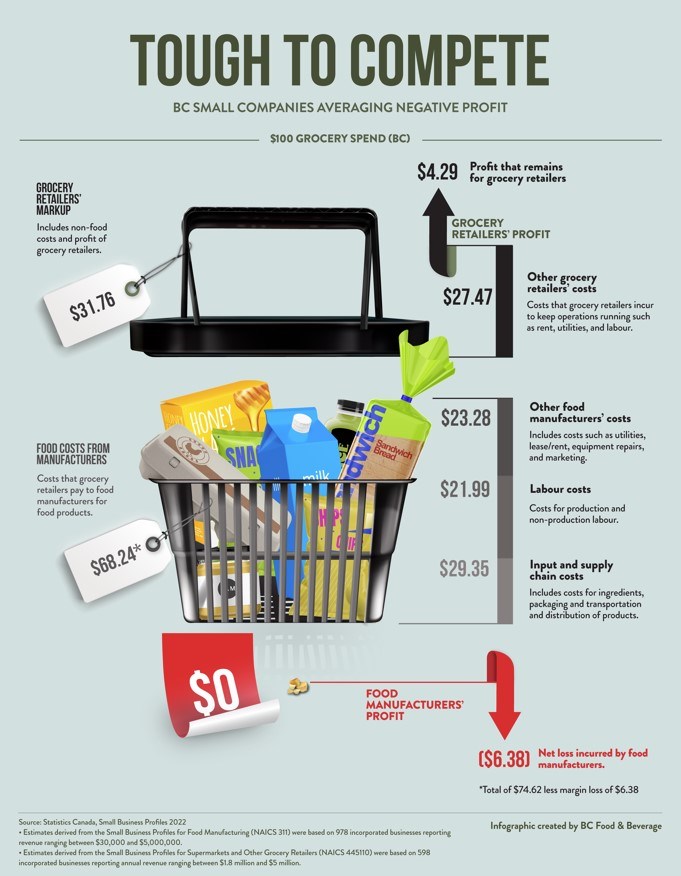Canadian grocers are generating record profits while food manufacturers are racking up losses, according to recent reports.
The industry association BC Food and Beverage released a report and infographics this morning to highlight how its members on average are enduring tough times. This follows the Centre for Future Work's report in December, which found that Canadian grocers were making record profits predicted to be more than $6 billion, up eight per cent year-over-year.
BC Food and Beverage broke down $100 in grocery spending to show where the money goes.
First of all, food manufacturers' net income on that $100 basket of food was a $6.38 loss, according to BC Food and Beverage.
After that amount is factored in, there was still $68.24 out of that $100 that went to food costs from manufacturers: $29.35 for input and supply-chain costs, $21.99 for labour costs and $23.28 in other food manufacturers' costs.
Grocers, in contrast, were making a $4.29 profit from that $100 food basket, while another $27.47 went toward what BC Food and Beverage called "other grocery retailers' costs."

BC Food and Beverage cited various Statistics Canada data points as its source in creating the information about the $100 food basket.
Its report said small-to-medium food manufacturers were actually enduring an average 9.3-per-cent net loss.
Some good news for B.C. food manufacturers is that supply chains have become more reliable.
“Supply chains are improving but they are very fragile,” BC Food & Beverage CEO James Donaldson told BIV earlier this month. “Everything is so interconnected.”
He said many members are watching nervously to see if 9,300 rail workers at Canadian National Railway Co. (TSX:CNR) and Canadian Pacific Kansas City Ltd. are able to reach new labour agreements, given that those workers earlier this month voted to authorize strike action.
His company's report found that increased pressure on margins from retailers was the biggest industry challenge, according to a survey, which found that 80 per cent of the respondents found it a major challenge and 15 per cent finding it a moderate challenge.
Rising costs to operate, the cost of skilled labour, and the cost to find appropriate buildings and land were also issues that were challenging to manufacturers, according to the report.
A top solution many manufacturers suggested, according to the report, was "government support to help address increased pressure on margins from retailers."
One issue that found traction with many business advocates and politicians who attended the May 21 Fraser Valley Economic Summit was the need to change Agricultural Land Reserve (ALR) rules to allow more food manufacturing on that land.
This would ease pressure on food manufacturers, which are forced to compete with other businesses for industrial land.
“Sunrise Poultry was kicking our tires a couple of years back because they wanted to amalgamate their processing plants,” Chilliwack Mayor Ken Popove told BIV after the summit. “All they ran into was roadblocks, and they're now in Alberta. That's going to happen more and more if the province doesn't step up to the plate and make some changes to [ALR regulations.]”
Premier David Eby addressed the issue at the economic summit, when he called it a "delicate balance.”
He said he wanted to ensure that "any changes that we make don't impact that affordability piece for farmers. We do want to continue to have food production on the ALR. We don't want it to be a situation where farmers are priced out."




